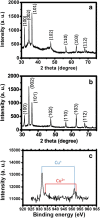Flexible Photocatalytic Paper with Cu2O and Ag Nanoparticle-Decorated ZnO Nanorods for Visible Light Photodegradation of Organic Dye
- PMID: 31201574
- PMCID: PMC6570720
- DOI: 10.1186/s11671-019-3034-7
Flexible Photocatalytic Paper with Cu2O and Ag Nanoparticle-Decorated ZnO Nanorods for Visible Light Photodegradation of Organic Dye
Abstract
We report on the fabrication of flexible photocatalytic paper comprised of Cu2O and Ag nanoparticle (NP)-decorated ZnO nanorods (NRs) and its application in visible light photodegradation of organic dye. ZnO NRs are first grown on a kraft paper substrate using a hydrothermal method. The NRs are subsequently decorated with Cu2O, Ag, or both NPs formed by photoreduction processes. Scanning electron microscopy and X-ray diffraction analysis confirm the crystallinity of ZnO NRs. Transmission electron microscopy analysis confirms the compositions of the two types of NPs. Four different types of photocatalytic papers with a size of 10 × 10 cm2 are prepared and used to degrade a 10-μM and 100-mL rhodamine B solution. The paper with Cu2O and Ag NP-co-decorated ZnO NRs has the best efficiency with first-order kinetic constants of 0.017 and 0.041 min-1 under the illumination of a halogen lamp and direct sunlight, respectively. The performance of the photocatalytic paper compares well with other substrate-supported ZnO nanocomposite photocatalysts. With the advantages of flexibility, light weight, nontoxicity, low cost, and ease of fabrication, the photocatalytic paper has good potential for visible light photocatalysis.
Keywords: Ag nanoparticle; Cu2O nanoparticle; Photocatalysis; Photocatalytic paper; ZnO nanorod.
Conflict of interest statement
The authors declare that they have no competing interests.
Figures









Similar articles
-
Enhanced photocatalytic performance of sandwiched ZnO@Ag@Cu₂O nanorod films: the distinct role of Ag NPs in the visible light and UV region.Nanotechnology. 2015 Mar 27;26(12):125403. doi: 10.1088/0957-4484/26/12/125403. Epub 2015 Mar 5. Nanotechnology. 2015. PMID: 25742195
-
Uncovering the Role of Surface-Attached Ag Nanoparticles in Photodegradation Improvement of Rhodamine B by ZnO-Ag Nanorods.Nanomaterials (Basel). 2022 Aug 22;12(16):2882. doi: 10.3390/nano12162882. Nanomaterials (Basel). 2022. PMID: 36014747 Free PMC article.
-
High Visible Photoelectrochemical Activity of Ag Nanoparticle-Sandwiched CdS/Ag/ZnO Nanorods.ACS Appl Mater Interfaces. 2017 Jan 11;9(1):658-667. doi: 10.1021/acsami.6b12259. Epub 2017 Jan 3. ACS Appl Mater Interfaces. 2017. PMID: 27982560
-
A Review on Cu2O-Based Composites in Photocatalysis: Synthesis, Modification, and Applications.Molecules. 2023 Jul 22;28(14):5576. doi: 10.3390/molecules28145576. Molecules. 2023. PMID: 37513448 Free PMC article. Review.
-
Cu2O as an emerging semiconductor in photocatalytic and photoelectrocatalytic treatment of water contaminated with organic substances: a review.RSC Adv. 2020 Oct 5;10(60):36514-36525. doi: 10.1039/d0ra06858f. eCollection 2020 Oct 1. RSC Adv. 2020. PMID: 35517951 Free PMC article. Review.
Cited by
-
Synthesis of Au/CdSe Janus Nanoparticles with Efficient Charge Transfer for Improving Photocatalytic Hydrogen Generation.Nanoscale Res Lett. 2019 Nov 27;14(1):349. doi: 10.1186/s11671-019-3185-6. Nanoscale Res Lett. 2019. PMID: 31776713 Free PMC article.
References
-
- Panda D, Tseng TY. One-dimensional ZnO nanostructures: fabrication, optoelectronic properties, and device applications. J Mater Sci. 2013;48:6849–6877. doi: 10.1007/s10853-013-7541-0. - DOI
-
- Udom I, Ram MK, Stefanakos EK, Hepp AF, Goswami DY. One-dimensional ZnO nanostructures: synthesis, properties and environmental applications. Mat Sci Semicon Proc. 2013;16:2070–2083. doi: 10.1016/j.mssp.2013.06.017. - DOI
-
- Wang Y, Chen Z, Lei T, Ai Y, Peng Z, Yan X, Li H, Zhang J, Wang ZM, Chueh YL. Hollow NiCo2S4 nanospheres hybridized with 3D hierarchical porous rGO/Fe2O3 composites toward high-performance energy storage device. Adv Energy Mater. 2018;8:1703453. doi: 10.1002/aenm.201703453. - DOI
-
- Ouyang W, Teng F, He JH, Fang X. Enhancing the photoelectric performance of photodetectors based on metal oxide semiconductors by charge-carrier engineering. Adv Funct Mater. 2019;29:1807672. doi: 10.1002/adfm.201807672. - DOI
Grants and funding
LinkOut - more resources
Full Text Sources
Other Literature Sources
Miscellaneous

